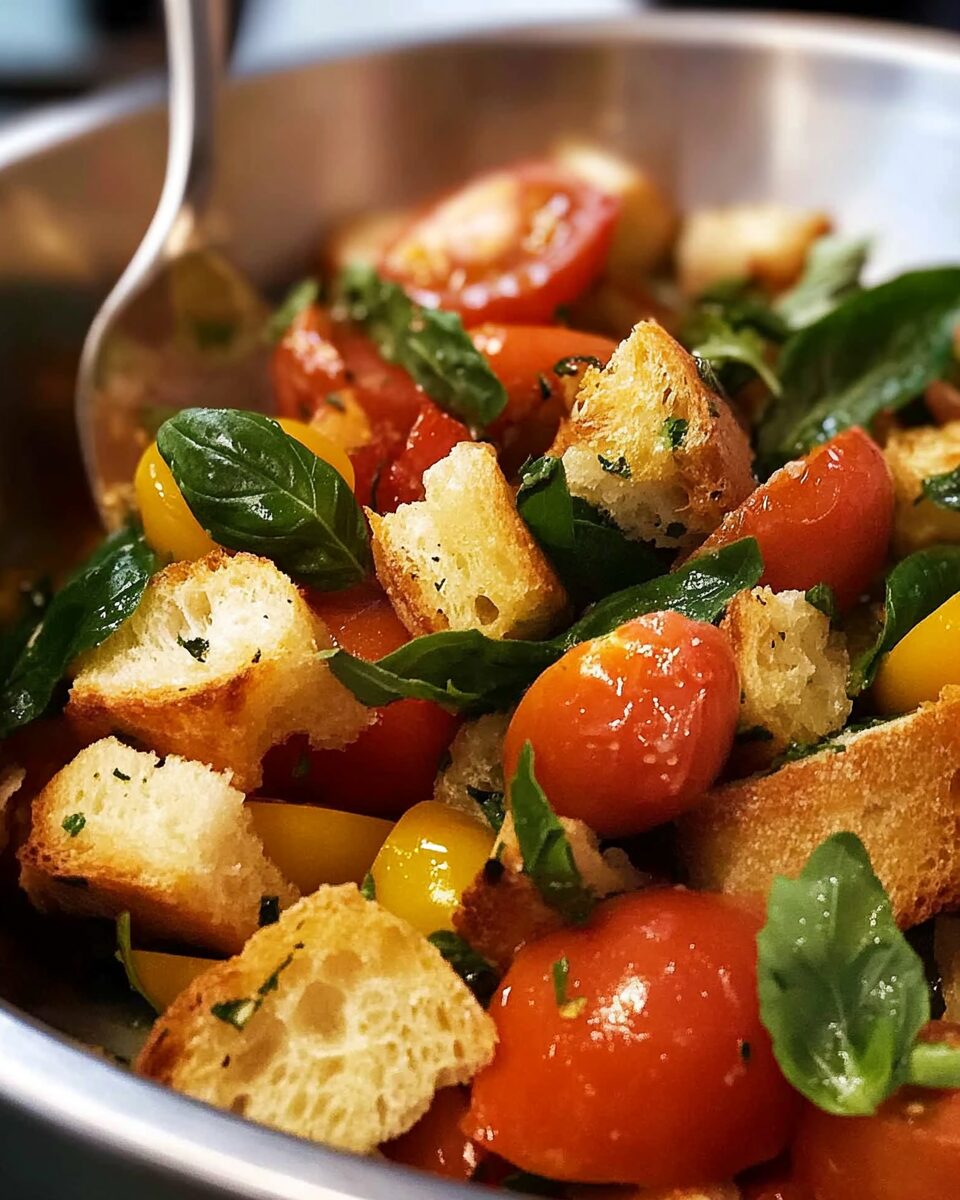Panzanella, a classic Tuscan dish, is a delightful way to enjoy summer’s freshest vegetables while repurposing stale bread into something delicious. The tangy bite of red wine vinegar combined with juicy tomatoes and crisp cucumbers creates a refreshing, yet satisfying salad.
The beauty of Panzanella lies in its simplicity and versatility. You can play with the ingredients by adding capers, olives, or even a hint of anchovy for an extra depth of flavor. Whether you’re enjoying it as a side or a light meal, this rustic bread salad brings a taste of Italy straight to your table, perfect for hot days when you crave something cool and hearty.
Full Recipe:
- 4 cups of stale bread, cut into bite-sized cubes
- 4 large ripe tomatoes, chopped
- 1 cucumber, sliced
- 1 small red onion, thinly sliced
- 1/4 cup extra virgin olive oil
- 2 tablespoons red wine vinegar
- 1/4 cup fresh basil leaves, torn
- Salt and pepper to taste
Directions:
- Start by soaking the stale bread cubes in water for about 10 minutes to soften them slightly.
- Drain the bread and gently squeeze out the excess water. Transfer to a large bowl.
- Add the chopped tomatoes, sliced cucumber, and red onion to the bowl.
- Drizzle the olive oil and red wine vinegar over the salad.
- Season with salt and pepper to taste, and toss everything together.
- Finally, sprinkle torn basil leaves over the salad and let it sit for 30 minutes before serving, allowing the flavors to meld together.
Prep Time: 15 minutes | Rest Time: 30 minutes | Total Time: 45 minutes
Kcal: 300 kcal | Servings: 4 servings
Panzanella: A Classic Italian Salad with a Rich History
The Panzanella Italian Tomato Bread Salad is not only a culinary delight but also a celebration of simplicity and ingenuity in the kitchen. Originating from Tuscany, Italy, Panzanella is a traditional bread salad that transforms stale bread and ripe, fresh vegetables into a flavorful, hearty dish. Its origins date back to the time when Italian farmers would repurpose their stale bread into a meal, making it an early example of food sustainability and creativity.
This dish exemplifies the essence of Italian cuisine—focusing on using a few high-quality ingredients to create something delicious and wholesome. While modern-day versions of Panzanella feature vibrant tomatoes and cucumbers, the earliest versions were made with onions, stale bread, and sometimes herbs, with tomatoes only being added later after their introduction to Europe.
Why Panzanella is a Summer Staple
- Refreshing and Light: Panzanella is the perfect dish for summer, thanks to its cool, refreshing ingredients like tomatoes, cucumbers, and fresh basil. The salad feels light but remains filling due to the bread component.
- Farmers’ Market Favorite: The salad is often made with fresh, seasonal produce, making it a favorite among those who shop at farmers’ markets. The quality of the ingredients shines through, especially when ripe tomatoes are in season.
- Versatile and Customizable: You can easily customize Panzanella based on what you have on hand. While the basic recipe calls for bread, tomatoes, cucumbers, and onions, some variations include ingredients like olives, capers, or even mozzarella cheese for added richness.
- Perfect for Entertaining: It’s an excellent dish for summer gatherings, picnics, or potlucks. Since it can be prepared ahead of time, Panzanella allows the flavors to meld together, making it even better after sitting for a while.
The Philosophy of Tuscan Cuisine
Panzanella is deeply rooted in the concept of “cucina povera”, or “poor kitchen,” a philosophy that emphasizes the use of simple, affordable, and often leftover ingredients to create wholesome meals. This idea of frugality and resourcefulness is at the heart of many Italian recipes, especially in the rural regions of Tuscany. The use of stale bread is one of the defining elements of Panzanella, showing how Italian cooking values minimizing waste while creating something that is both satisfying and nourishing.
Health Benefits of Panzanella
In addition to being delicious, Panzanella offers a number of health benefits that make it a great addition to a balanced diet. Here are a few of the key health advantages of this dish:
- Rich in Nutrients: The tomatoes, cucumbers, and onions in Panzanella are packed with vitamins, minerals, and antioxidants. Tomatoes are rich in lycopene, an antioxidant linked to reduced risk of heart disease and cancer, while cucumbers provide hydration and fiber.
- Heart-Healthy Fats: The use of extra virgin olive oil as the dressing adds heart-healthy monounsaturated fats to the dish. Olive oil is a staple of the Mediterranean diet, which is associated with numerous health benefits, including improved cardiovascular health and longevity.
- Low in Calories: Panzanella is naturally low in calories, especially if you go light on the bread. It’s a great option for those looking to enjoy a filling meal without overindulging in calories. The fiber from the vegetables and bread also helps keep you feeling full for longer.
- Hydrating: With cucumbers and tomatoes being high in water content, this salad is also incredibly hydrating, making it an ideal dish for hot summer days.
Different Variations of Panzanella
Panzanella’s simplicity makes it a versatile dish that can be adapted to different tastes, dietary preferences, or ingredient availability. While the classic version focuses on bread and tomatoes, there are countless ways to experiment with the salad:
- Caprese Panzanella: By adding mozzarella cheese, this variation combines the best of Panzanella and Caprese salads. The creamy cheese adds richness, making the salad even more satisfying.
- Grilled Panzanella: Grilling the bread or even some of the vegetables can add a smoky flavor and crisp texture to the salad. This is a great twist if you’re serving the salad at a BBQ or outdoor gathering.
- Seafood Panzanella: In coastal areas of Italy, seafood such as anchovies or tuna is sometimes added to the salad for extra protein and umami flavor.
- Green Panzanella: A more modern take, some chefs add leafy greens like arugula or spinach to the salad to increase the vegetable content and create a fresher, more vibrant dish.
- Fruit-Inspired Panzanella: Some variations include adding fruits like peaches or watermelon to bring a sweet contrast to the savory ingredients. This is especially popular in regions where fresh summer fruits are abundant.
Tips for Making the Perfect Panzanella
- Use Stale Bread: The key to making authentic Panzanella is using stale bread. Fresh bread will become too soggy in the salad. If you don’t have stale bread on hand, you can quickly toast fresh bread in the oven until it’s dry and slightly crisp.
- Let the Salad Sit: One of the secrets to a good Panzanella is letting it sit for at least 30 minutes before serving. This allows the bread to soak up the dressing and the flavors to meld together.
- High-Quality Ingredients: Since Panzanella relies on just a few simple ingredients, their quality matters. Use the ripest tomatoes, freshest basil, and a good-quality olive oil to make the salad truly stand out.
- Balance the Dressing: The balance of oil and vinegar is crucial to the flavor of the salad. A general ratio of three parts olive oil to one part vinegar works well, but you can adjust it to your taste. Some prefer a more acidic bite, while others like a milder flavor.
- Season Generously: Don’t forget to season the salad with plenty of salt and pepper. This brings out the flavors of the vegetables and enhances the overall taste of the dish.
Serving Suggestions
Panzanella is incredibly versatile when it comes to serving. While it’s traditionally served as a side dish, especially in Tuscan homes, it can also be enjoyed as a light main course or as part of a larger spread of Italian dishes. Here are a few serving ideas:
- As a Side Dish: Serve it alongside grilled meats or fish for a well-rounded summer meal. The refreshing qualities of the salad complement the richness of grilled foods perfectly.
- Light Lunch: Enjoy Panzanella as a light, standalone meal on a hot day. Its combination of bread and vegetables provides enough sustenance without being too heavy.
- Part of a Picnic or Potluck: Since Panzanella can be made ahead of time and actually improves with time, it’s an ideal dish to bring to outdoor events, picnics, or potlucks.
- Pair with Wine: For a complete Italian dining experience, pair Panzanella with a crisp white wine such as Pinot Grigio or a light rosé. The wine’s acidity will complement the salad’s flavors without overpowering them.
The Cultural Significance of Panzanella
Panzanella isn’t just a dish; it’s a reflection of Italian culture and its focus on food as a means of bringing people together. In Tuscany, where the salad originates, food is often at the heart of social gatherings, family meals, and celebrations. Panzanella’s origins in the “cucina povera” tradition remind us of the importance of simplicity, sustainability, and community in Italian cuisine.
In many ways, Panzanella symbolizes how food can turn something humble, like stale bread, into something extraordinary. It highlights how cooking can be both practical and pleasurable, transforming leftover ingredients into a dish full of flavor, texture, and satisfaction.
Conclusion: Why Panzanella is a Must-Try
Whether you’re a seasoned home cook or just starting your culinary journey, Panzanella is a dish that everyone can enjoy. Its simplicity, versatility, and ability to showcase fresh, seasonal ingredients make it a must-try, especially during the warmer months. The combination of juicy tomatoes, crispy cucumbers, fragrant basil, and tangy olive oil dressing is refreshing yet hearty, offering a perfect balance of flavors and textures.
Moreover, Panzanella’s adaptability allows you to make it your own, adjusting ingredients based on personal preferences or what you have on hand. It’s a dish that can be enjoyed in so many settings—whether at a family meal, a summer barbecue, or a casual lunch. Once you’ve tried it, you’ll understand why Panzanella has remained a staple in Italian cuisine for centuries.






